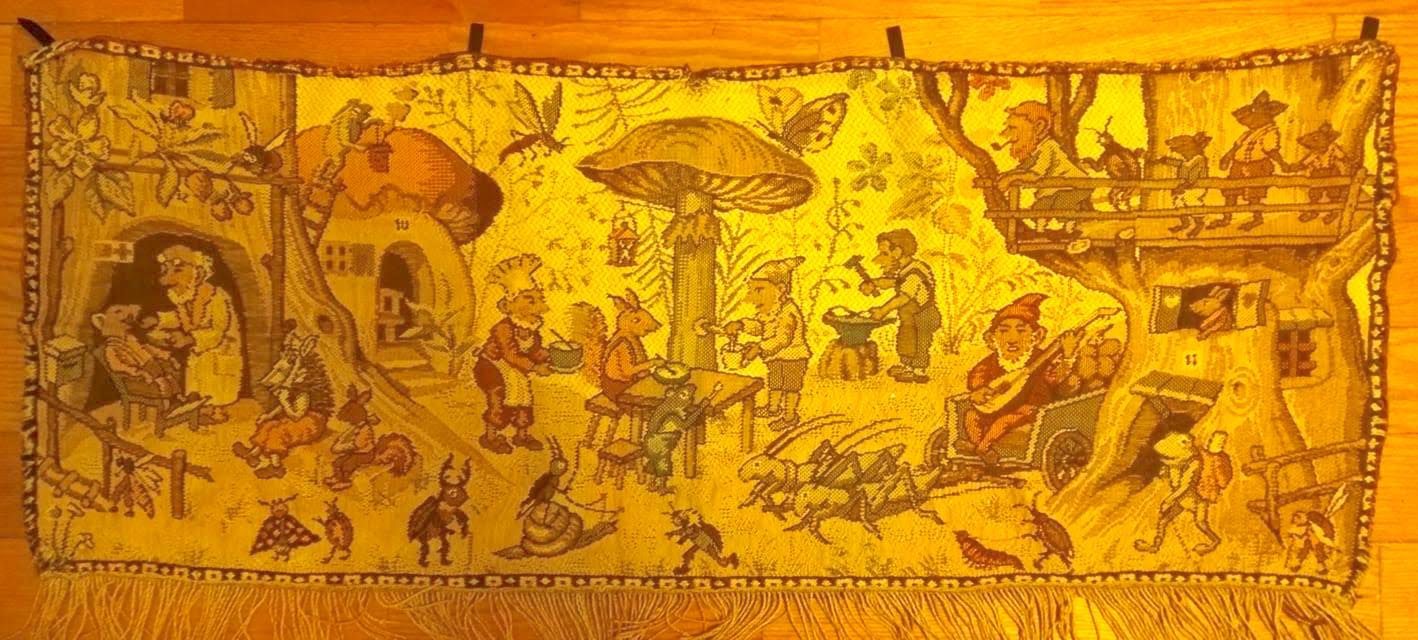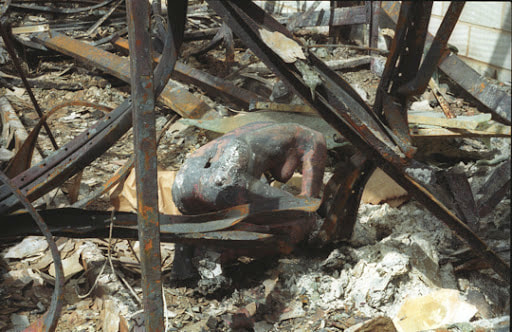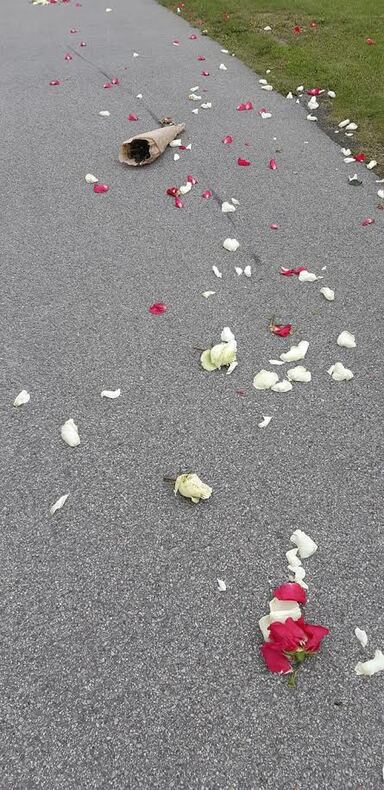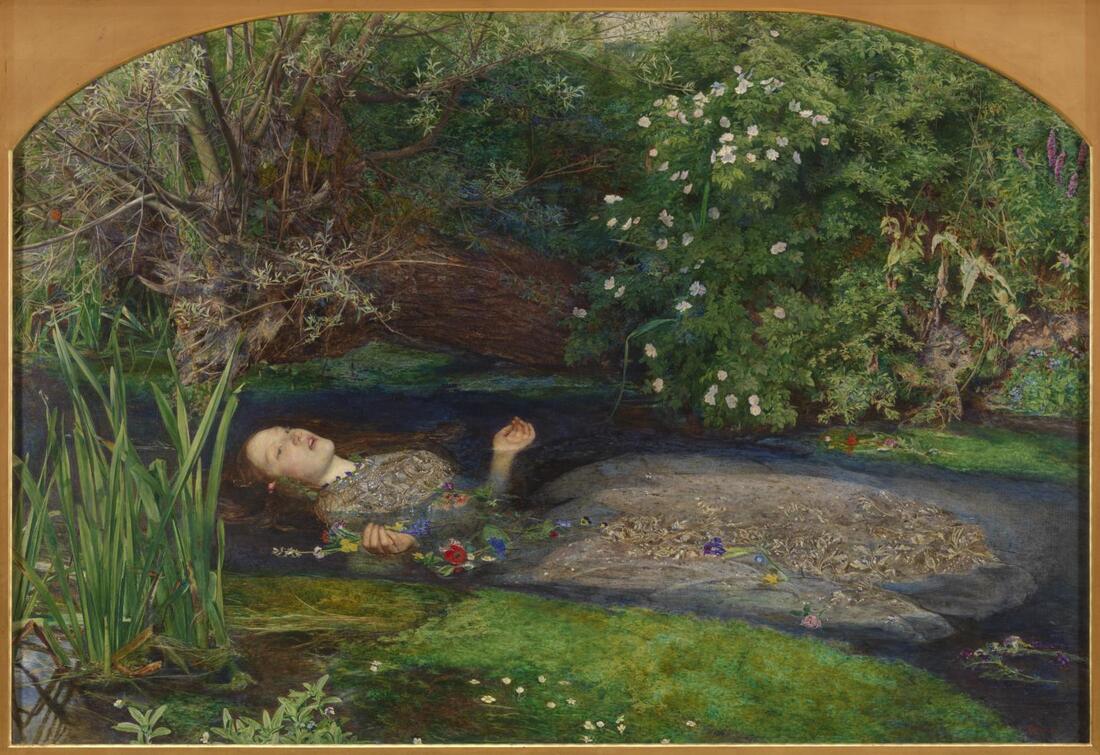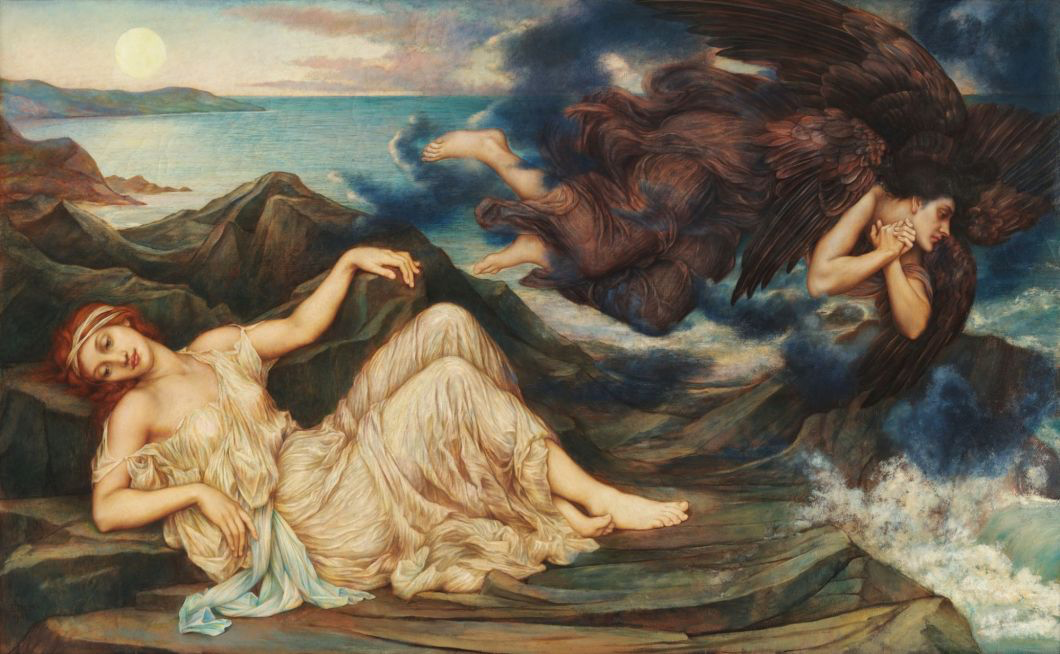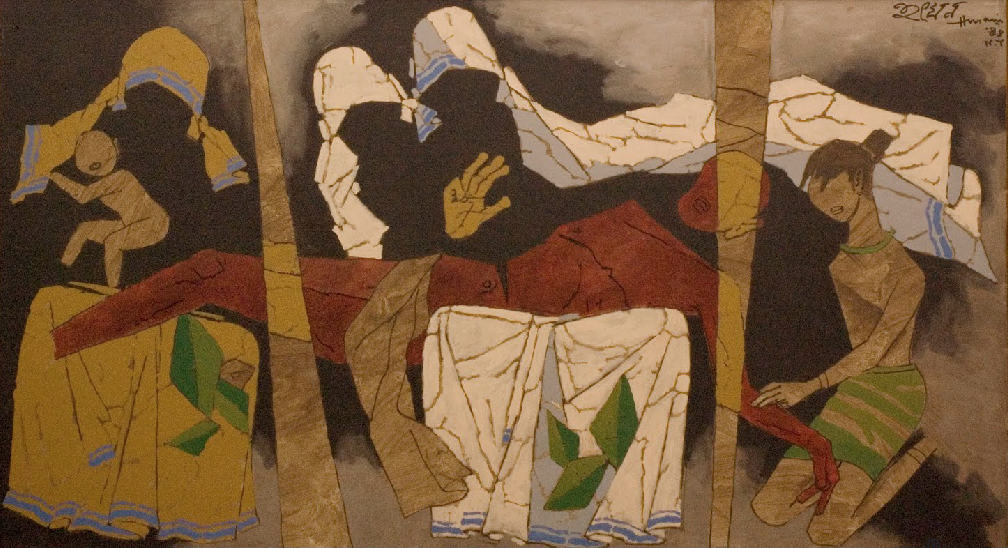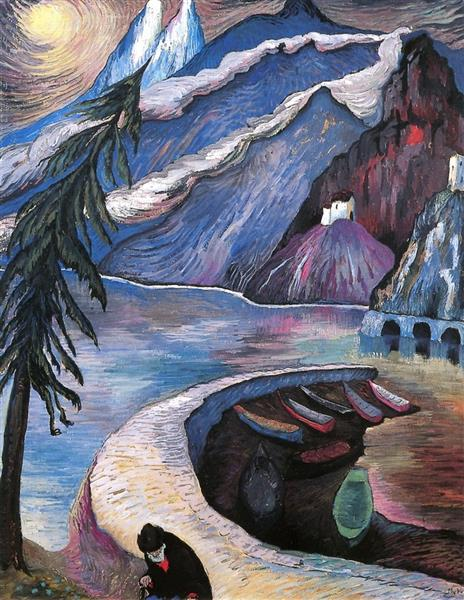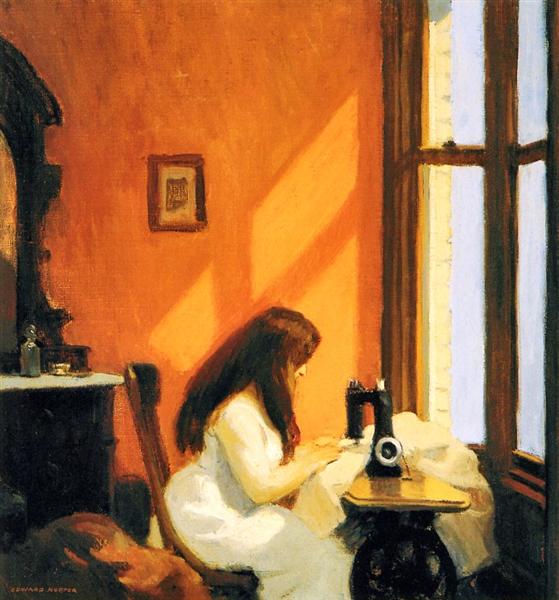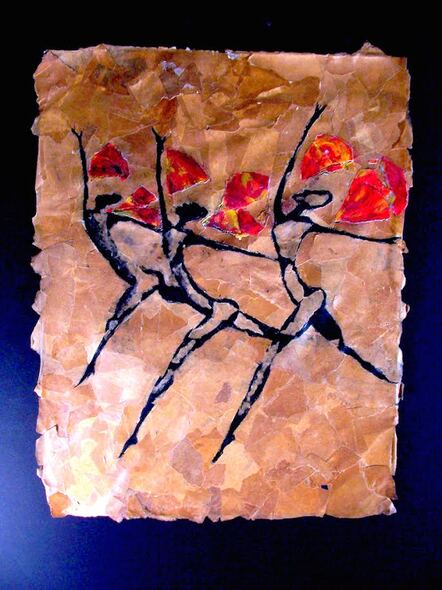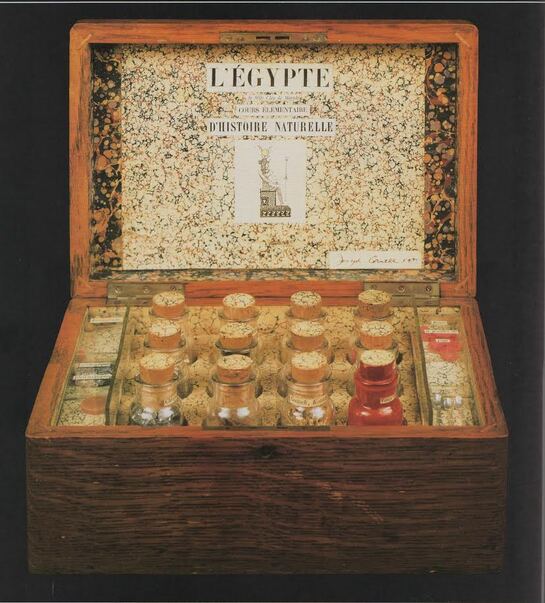|
РАССКАЗ О СТАРОМ КОВРИКЕ (Russian) Этот коврик висел над моей кроватью в детстве, а до моего детства он висел над кроватью моего брата, а намного раньше - над кроватью моей мамы. Видите бахрому внизу? Когда я была маленькая, я заплетала эту бахрому в косички, также как мама заплетала косички мне. Я долго не могла научиться сама заплетать свои волосы и тренировалась на бахроме этого коврика. А ещё, глядя на этот коврик (снизу вверх, так как я глядела на него лёжа в кровати), я думала об изображенных на нём гномах. Видите, вот этот, в центре, в жёлтой остроконечной шляпе, наливает сок в чашку из большого гриба. Рядом, за столом под грибом, сидит белка со столовой ложкой в руках, кашу в миске размешивает (надеюсь, не манную). Тут же лягушка в штанах, тоже с ложкой в руках, терпеливо ждёт своей очереди. А слева, видите, большое дупло, и в нём Доктор Айболит лечит мышонка. А в очереди к Айболиту сидит ёж с перевязанной шеей и бельчонок с рукой в гипсе. Справа от гриба – гном-кузнец кует молотом по наковальне, а сама наковальня стоит на пеньке, похожим на маленький кекс. За гномом-кузнецом -- гном с балалайкой в руках, то ли в инвалидной коляске, то ли в свадебной карете, запряженной парой кузнечиков. За ним – раскидистое дерево и дверь в него и окно со ставнями; из окошка высунулся мышонок – то ли брат, то ли сын того мышонка, которому Айболит лечит зубы в левом углу ковра. На балконе этого дерева идёт веселье - тут и гном с трубкой в зубах и крысенок и целая вереница зверят. Всё это я разглядывала часами, днями, утрами, ночами, засыпая и просыпаясь, заплетая коврику косички и расплетая их, заплетая и расплетая. Этот коврик путешествовал с нами из страны в страну и много лет висел над моей кроватью в нашей квартире в Forest Hills, но в том возрасте я на него смотрела гораздо реже и не заплетала ему косички из бахромы. Когда я стала совсем взрослая, мы его почему-то сняли со стены, возможно, из-за ремонта, не помню точно, и он много лет провалялся на полке с какими-то наволочками, забытый всеми. Когда родилась дочка, я его разыскала. Я хотела, чтобы память о прошлом передавалась через него от поколения к поколению, от меня к ней. Повесила его над дочкиной кроватью, сказала «Смотри! Видишь, гном наливает сок из гриба в чашку, а белка размешивает ложкой кашу, надеюсь, не манную." Но моей американской дочке был не интересен этот старый серенький коврик. Она привыкла к ярким электронным игрушкам, видео, компьютерной рисовальной доске. Коврик был снят со стены не помню кем, когда мы переезжали, и потерялся. Я не видела его много лет. И только позавчера нашла его на какой-то полке. Он такой же, как был много лет назад, только давно ему никто не заплетал косички. Story About the Old Wall Rug When I was a child, this wall rug hung over my bed, and before I was born, it hung over my brother's bed, and many years earlier it hung over my mother's bed. See the fringe below? When I was little, I braided it in pigtails, just like my mother braided my hair. For a long time, I couldn’t learn to braid my hair myself and practiced on the fringe of this rug. And also, looking at this wall rug (from the bottom up, since I was looking at it while lying in bed), I thought about the gnomes depicted on it. See, this one in the center, in a yellow pointy hat, is pouring juice into a cup from a large mushroom. Nearby, at the table under the mushroom, sits a squirrel with a tablespoon in his hands, stirring porridge in a bowl. And in front of the table stands a frog in trousers, also with a spoon in hand, patiently waits for his turn. And on the left, you can see a large hollow in the tree, where Doctor Aibolit* is treating a mouse. Patients are waiting to see Doctor Aibolit: a hedgehog with a bandaged neck and a squirrel with its arm in a cast. To the right of the mushroom is another gnome, a blacksmith who hammers the anvil which stands on a stump, like a small cake. Behind the blacksmith gnome is another gnome, with a balalaika in his hands; he is sitting either in a wheelchair or in a wedding carriage drawn by a pair of grasshoppers. Behind him is a spreading tree, and it has a door and a window with shutters: a mouse leans out of the window - either a brother or the son of that other mouse, the one whose teeth Doctor Aibolit is treating in the left corner of the carpet. And take a look at the balcony of the tree - there is a gnome with a pipe in his mouth, and rats and a whole queue of animals. I looked at all this for hours, days, mornings, nights, falling asleep and waking up, braiding the braids and unweaving them, braiding and unweaving. This rug traveled with us from country to country and for many years hung over my bed in our apartment in Forest Hills, but at that age I looked at it much less often and did not braid the fringe. When I became an adult, we took it off the wall, probably because all the walls in our apartment had to be repainted, I don't remember exactly, and for many years it lay on a shelf with some kind of pillowcases, forgotten by everyone. When my daughter was born, I tracked it down. I wanted the memory of the past to be passed on through this wall rug from generation to generation, from me to her. I hung it over my daughter's bed, saying “Look at it! So many years have passed, and the gnome is still pouring the juice from the big mushroom into the cup, and the squirrel is still stirring the porridge with a spoon”. But my American daughter was not interested in this old wall rug. She was used to bright electronic toys, videos, the speed of the internet, a laptop drawing board. I can’t remember who removed the rug from the wall when we moved. After this it was lost again, and I didn’t see it for years. Only the day before yesterday I found it lying in an old closet. It is still the same as it was many years ago, only it’s been a while since anyone braided its braids. Nina Kossman * Doctor Aibolit – literally Dr. Ouch-It-Hurts, a doctor from a famous children’s poem by Kornei Chukovsky. Moscow born, Nina Kossman is an artist, bilingual writer, poet, translator of Russian poetry, painter, and playwright. Her paintings and sculptures have been exhibited in Moscow, Philadelphia, and New York. Her English short stories and poems have been published in US, Canadian and British journals. Her Russian poems and short stories have been published in major Russian literary journals. Among her published works are two books of poems in Russian and English, two volumes of translations of Marina Tsvetaeva’s poems, two collections of short stories, an anthology (Gods and Mortals: Modern Poems on Classical Myths) published by Oxford University Press, and a novel. Her new book of English poems, Other Shepherds, is forthcoming from Poets & Traitors Press. Her work has been translated into Greek, Japanese, Russian, and Spanish. She received a UNESCO/PEN Short Story Award, an NEA translation fellowship, and grants from Foundation for Hellenic Culture, the Onassis Public Benefit Foundation, and Fundacion Valparaiso. She lives in New York.
0 Comments
Study in Grey —after the Momart warehouse fire “This news comes between Iraqi weddings being bombed and people dying in the Dominican Republic in flash floods—so we have to get it into perspective. But I’m really gutted.” Tracey Emin “If the insurers decide the fire is an act of God…that God destroyed Hell… I will start going to church.” Dinos Chapman A warehouse is on fire in England. Inside a hundred works of contemporary British art are burning. In subsequent days some mourn multi-media passions gone to ash; others claim nothing of value was lost. Both are correct. One creation within the blaze is labeled HELL, an interactive piece. Sleepwalk around it. Look inside the glass cases: Nazis scream as they kill one another. We should have known Hell would never freeze over. We should have known it would go up in flames. Even the artist, same day separate interviews, says “It is only art. It can be replaced” and later “It is irreplaceable.” His remarks do not contradict themselves. If we imagine they do, the contradiction lies—smoldering—within me and you. Meanwhile, in an alternate, avant-garde life, I sell my Grandmother’s oil paintings and Lara drops her black dress to cross the ocean and crash the opening of that scorched exhibit created by human forces beyond control. Her hand small on my arm, what we were alters within the embers of our ad-libbed performance art—an effigy to no truth but our own—as fire re-imagined toy Nazis softening, the little death camp chimney collapsing, the soldiers’ faces running as grey-uniformed limbs splash into a bubbling morass.* Back in this still life, our separate truths wax and wane: no way to know what is more true-- what had been created, what has been destroyed into being. William Rudolph * italicized text adapted from The Guardian. The image above is one of many from the fire and was chosen to accompany the poem by the editor. William's poem was inspired by the fire itself. This poem first appeared in 3Elements Review. William Rudolph earned his MFA in Writing from Vermont College where his mentors included Mark Cox, Jody Glading, Leslie Ullman, and Roger Weingarten; he also has studied poetry under Edward Hirsch at Breadloaf and both Jane Mead and Katie Ford at the University of Iowa. His poetry has appeared in Barrow Street, Flint Hills Review, Midwest Review, North Dakota Quarterly, The North American Review, Quarterly West, Rattle, SLANT, Steam Ticket, and many other journals. He coaches student writers at Grinnell College and in GC’s Liberal Arts in Prison Program. Strewn Flowers The flowers came... too thoughtless, too late, "too cheap" is what I said to him. He thought it was about the money, I meant it was the thought... last-minute, like something he had to do. So I did something I had to do, should have done a while back Now it's done He's gone, flowers too, strewn petals in the past. Dan Franch Originally from Chicago, Dan Franch currently resides in the country of Estonia. Currently a language teacher in Estonia, he has traveled extensively, has lived in six countries, and has had a wide variety of random life experiences. Restless by nature, Dan is doing his best to settle into an extended stay in his children's homeland. Ophelia I am at the riverbank drowning in your tears, Ophelia. Why call for me? Your soul rests in Rue. Your soliloquy lives in aloe. You’re a haunting echo. I listen to your eulogy, my heart is speechless and wanders in a water dreamscape; in remembrance it feels, in freedom it breathes, and in love it lives. A lotus blooms in my depths, lilies grow on my skin and roses bloom in my palms. I wish you would see me walk on water, Ophelia. Enas R. Enas R. is a contemporary artist born in Riyadh, Saudi Arabia. Enas is a multidisciplinary who grew up with a passion for all forms of art and enjoys painting and creative writing. She holds a BA in English literature and a postgraduate degree in Learning and Development and practiced art all her life as her personal passion. She believes in expressing emotions in various surreal ways that transcend form by painting with words and writing in colours and bringing two magical worlds of reality and imagination together in order to create a new way to communicate and connect with people across all cultures. Her poems have been featured on Greythoughts. Find more about her artwork on instagram: @_Artistenas Summer Fling Summer crashes in one day, drunk as usual full of crude jokes and maudlin love poems, and you can’t help yourself: he’s a drug, he’s a bad boy he serves a heady cocktail of nights at seventeen, driving alone past fields of fireflies, the constellations that held your hand through heartbreak, through the creak and snap of growing up. Summer keeps those stars in his pocket, and brings them out just as you tire of humidity and air conditioning, the too-obvious beauty of peonies, zinnias, asters. And you are seduced again, your old body feels silvery and touchable, and before long you’re drinking wine naked by the edge of a pond, planning your next good life. Sara Eddy Sara Eddy: "I am the assistant director of the writing centre at Smith College, in Northampton, Massachusetts. Some of my poems have appeared recently or are forthcoming in Threepenny Review, the Baltimore Review, and Spank the Carp. My chapbook of poems about bees and beekeeping, Tell the Bees, was released in October of 2019 by A3 Press, and another chapbook of poems about food, Full Mouth, will come out from Finishing Line Press in October 2020. I live in Amherst, Massachusetts with a teenager, a black cat, a white dog, and three beehives." The Other Queens of Calcutta #27 chattogram / park circus / tiktok breaks the kanoon every day but not to be blamed for teish may #29 ekdalia / gariahat / rashbehari feasts on men and mutton chops from gopal patha’r mangsho shop #13 bow barracks / dalhousie quit phishing at peerless inn to learn mah-jong for stockbroking #18 zie / marxist / probashi does the merengue in hong kong shoes for homeless kids in metiabruz #03 parishad girl for -.. .. -.. .. party-shill on news tv with decibel level = goswami #22 farmer / migrant / leftist jhalmuri mashi from nandigram who knows the truth of chit fund scam #33 markin / yogini / revivalist tomar naam, amar naam; v̶i̶e̶t̶n̶a̶m̶ jai shri ram Sahana Ahmed Sahana Ahmed is a fiction writer and poet from Gurugram, India. She is the author of Combat Skirts (Juggernaut Books, 2018; Quignog, 2018), a novel based in the Calcutta of the nineties. Find her online at www.sahanaahmed.com. Forget-Me-Nots Sun spins over mountains as blue as ocean snow for waves smaller hills pose in burgundy and magenta- infused light as villages-- helpless against rocky tsunami frozen above them cracking at any moment splintering into a drizzle of sleet. All this reflected in water-- ocean-mountains snow-waves hill-villages stone-tsunami. There is a tree a windblown pine pointing to sun overseeing boats that lie like so many mismatched shoes-- bone-blue and aqua and ballet-pink—scattered on the loamy shore and the old man who clomps along in black his cane a stag’s horn his back a half-moon over clusters of forget-me-nots. t.m. thomson t.m. thomson’s work has most recently appeared in West Trade Review and Borrowed Solace and will appear in The Voices Project and Pensive in the upcoming months. Three of her poems have been nominated for Pushcart Awards: “Seahorse and Moon” in 2005, “I Walked Out in January” in 2016, and “Strum and Lull” in 2018. She is the author of Strum and Lull (2019) and The Profusion (2019), which placed in Golden Walkman’s 2017 chapbook competition, and co-author of Frame and Mount the Sky (2017). She has a writer’s page at https://www.facebook.com/TaunjaThomsonWriter/ Dharma You’ll often find me alone, inside these orange walls, Alone with my work and the silence the walls contain. Every day I sit in front of my machine and this high reaching window And feel time move around me. Some days, I’m Rapunzel, yearning to unravel my hair and be rescued. Some days, I’m the Miller’s daughter, willing to bargain away my solitude. And yet, I relinquish. I breathe deeply, position myself, lift foot against pedal, And let the rise and fall of the slender needle call me back. I disappear into my craft. Some days, like today, the high reaching window fills with light And illuminates me. Focus fills me and I rest in the knowing That my silent doing matters. A loyal servant, this machine knows only a woman’s touch. It had been my mother’s, brand new and filled with possibility. Now it’s mine, slightly tarnished but not diminished In prospect or expectation. I mend the fabric of necessity and comfort. Stitch by stitch beauty emerges. Thread by thread the pattern takes form. Our legacy is shaped in the cloth. Cristie Newhart Cristie Newhart is the Dean of the Kripalu School of Yoga, and has been a faculty member at Kripalu for 20 years. She exudes equal parts warmth and wisdom as she makes some of yoga’s deeper philosophical aspects engaging and accessible to modern-day practitioners. Cristie is a writer, writing for Kripalu and herself in blogs and articles. She is a deep lover of poetry, art, nature and all forms of expression. Cristie lives in the Berkshires of Western Massachusetts.
alight and aligned within in-between and beyond our selves
Creators' note: Our hybrid prose/poetry project (unpublished so far) entitled Black & White and In-Between chronicles our twenty-year friendship and explores our differences in age, professional status, and racial identity. The final chapter was inspired by a third partner, African-American artist Jean Berry whose mixed media collage Leap 3 led us each to put words to the expressive imagery of her art. The syncopated triple movement of Leap 3 visualizes for us the interconnectedness of our words & works of art, as it celebrates the inherent hybridity of people, poems, prose, and art that surrounds and sustains us, especially in the age of Covid-19 and Black Lives Matter. Jan Gross is a retired college professor of French; H. L. Viravong is a college administrator. Beyond their academic careers, they discovered creative writing as an outgrowth of their initial contact as mentor-mentee at the same academic institution. They now live far apart (H.L. in Pennsylvania; Jan in Iowa), but continue their poetic collaboration in Black&White and In-Between, a memoir of intergenerational and interracial friendship. Their discovery of African-American artist, Jean Berry, inspired them. Jean began her art career late in life. Her pieces in charcoal and pastel mine the depths of human emotion and celebrate the graceful beauty of black bodies in movement. Iowa-based, Jean has earned international acclaim for her timeless images. http://jeanberryart.com Joseph Cornell's L'Egypte de Mlle Cleo De Merode On a layer of red sand beneath glass: broken piece of comb, frosted slivers for reflection. Porcelain doll’s arm, broken at elbow, for fitting her into his frame. Plastic rose petals for throwing at her feet, preserving her beauty. Three miniature tin spoons for measuring out sand grains in her hourglass. Twelve cork-stopped apothecary jars filled with spirits: crumpled tulle, blue celluloid, bone fragments, for curing all ailments. Metal chain, rhinestones, sequins, pearl beads, for seduction. He labels the jars: Grasshoppers and locusts. An instrument to measure the Nile’s waters. Sphynx. L’emeraudes de Cléo de Mérode. In one jar, Cleopatra’s needle is threaded. In another, his Queen’s entombed, dancing on yellow sand, a pinned butterfly. Lisa Fleck Dondiego Lisa Fleck Dondiego’s poems have appeared in The Sigh Press Literary Journal, The Westchester Review, The Writers Circle 2, Memoir Mixtapes, The Writers’ Café, Periwinkle, and in the Ecopoetics 2020 special edition of Dispatches from the Poetry Wars, as well as in several anthologies, including Red Moon Press’s yearly anthology and the Contemporary Women Writers of the Hudson Valley’s A Slant of Light. Work is forthcoming in Salamander. Her chapbook, A Sea Change, was published by Finishing Line Press in 2011. She lives in Ossining, NY, with her husband. |
The Ekphrastic Review
COOKIES/PRIVACY
This site uses cookies to deliver your best navigation experience this time and next. Continuing here means you consent to cookies. Thank you. Join us on Facebook:
July 2024
|
